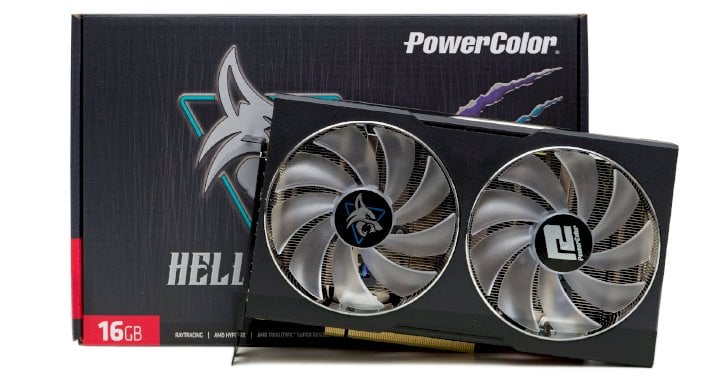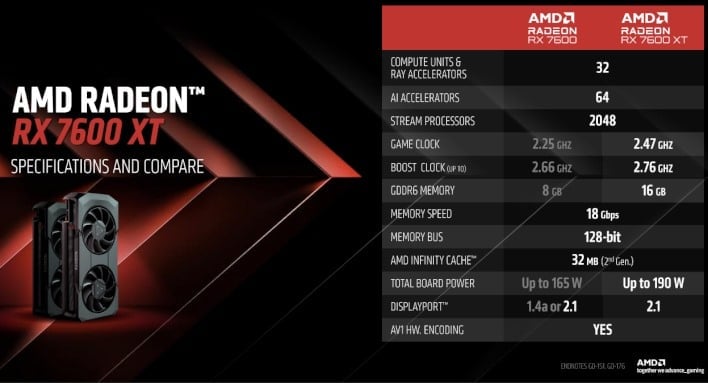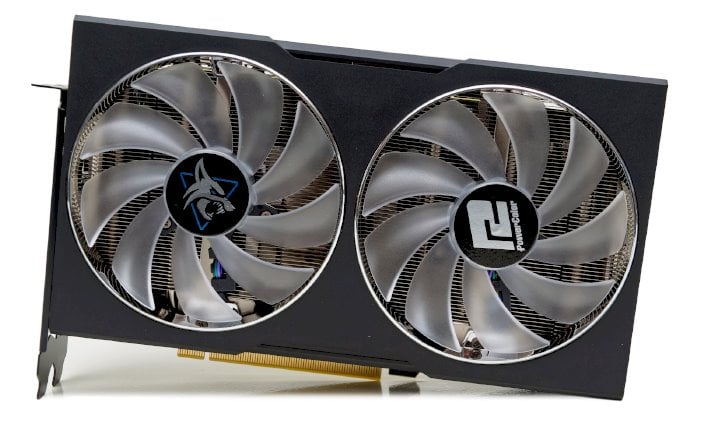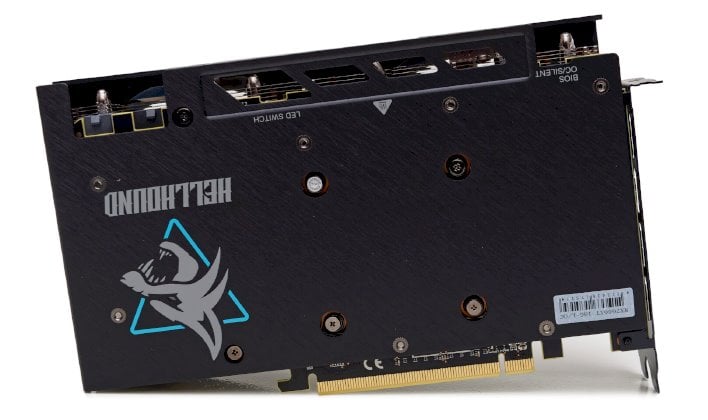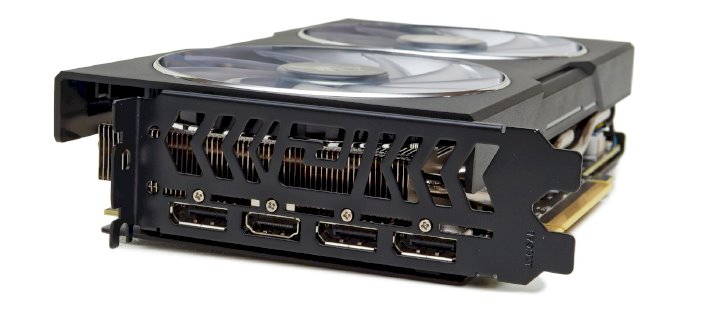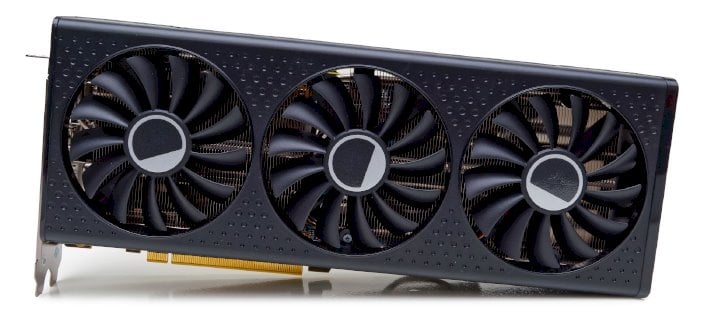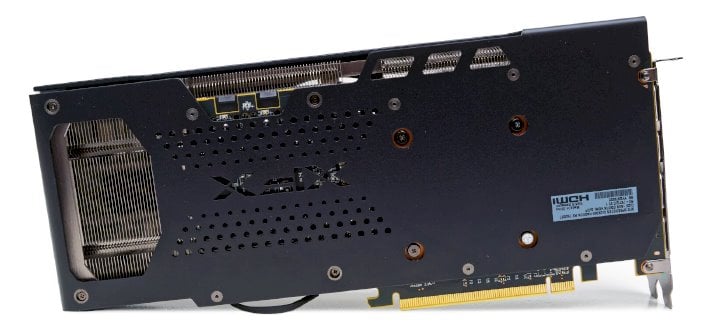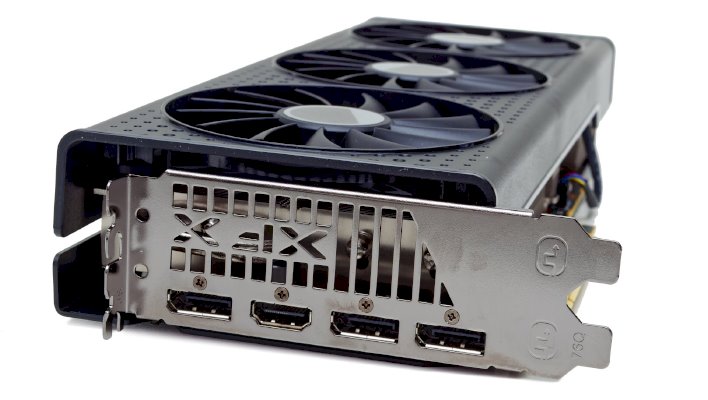AMD Radeon RX 7600 XT Review: 1080p PC Gaming With PowerColor And XFX
XFX And PowerColor Radeon RX 7600 XT: Higher Clocks And More Memory Boost Performance
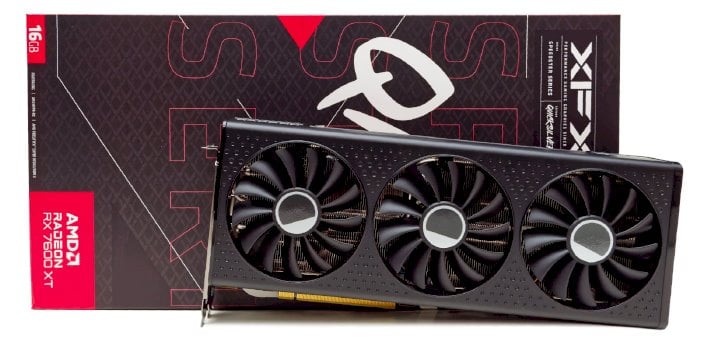
| AMD Radeon RX 7600 XT: MSRP Starting @ $329 The affordably-priced Radeon RX 7600 XT has higher GPU clocks and double the VRAM of its predecessor to boost performance for mainstream PC gamers.
|
|||

|

|
||
Along with announcing a bevy of upcoming mobile and desktop processors, AMD used CES 2024 to reveal a new addition to its mainstream graphics card line-up, the Radeon RX 7600 XT. We took a look at the original Radeon RX 7600 all the way back in May of last year and found it to be a competent card for 1080p gamers on a budget. As has historically been the case, slapping that “XT” moniker on a Radeon means it’s been updated or upgraded in some way, and that certainly holds true here. The Radeon RX 7600 XT is treated to higher clocks, some additional power headroom, a DP 2.1 requirement (it was optional on the 7600), and double the memory. Another major difference is that AMD won’t be making reference cards for the Radeon RX 7600 XT, and is instead relying on board partners to bring the card to market.
We’ve actually got a pair of Radeon RX 7600 XTs on hand for testing, one from XFX and another from PowerColor. Before we get down to business though, let’s first get some particulars out of the way...
AMD Radeon RX 7600 XT Super Specifications
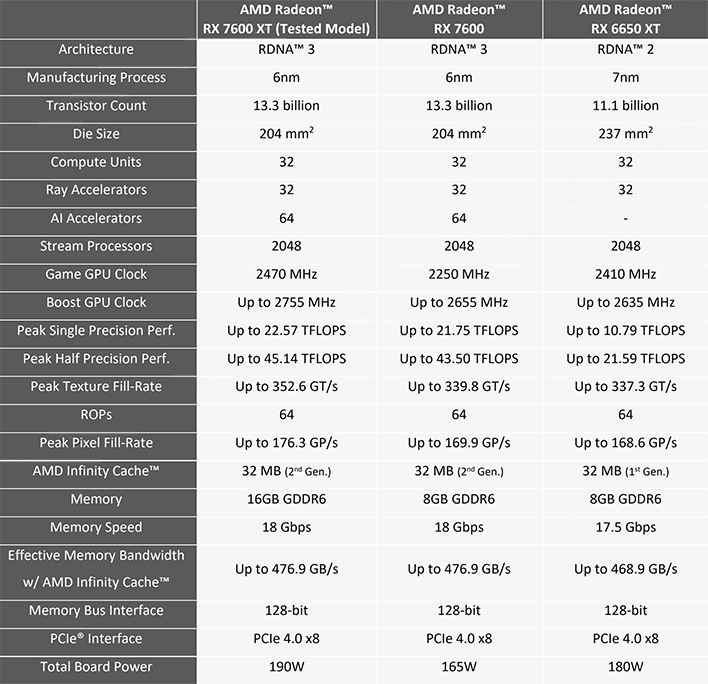
Like all of the other members of the Radeon RX 7000 series, the RX 7600 XT leverages AMD’s RDNA 3 graphics architecture; the Navi 33 GPU powering the card is simply scaled back to address a different market segment and performance target.
The Radeon RX 7600 XT, like the original 7600, features 32 of the same unified compute units as higher-end cards in the family, including the same AI and 2nd-generation ray tracing accelerators. It’s also got an updated media engine with support for hardware AV1 encoding, and the Radiance Display Engine with the aforementioned support for DisplayPort 2.1.
Per AMD’s reference specs, the Radeon RX 7600 XT offers boost clocks up to 2.755GHz with typical game clocks of about 2.470GHz. Both of the cards we’ll be featuring here operate at similar real-world clocks in our tests.
The RDNA architecture, additional cores, and higher clocks mean the Radeon RX 7600 series offers higher compute performance and somewhat higher fill rates versus previous-gen Radeons in its class – you can see a comparison in the table above to the Radeon RX 6650 XT. The Radeon RX 7600 XT’s outfitted with 32MB of second-gen Infinity Cache; the RX 6650 XT has a similar amoutn of 1st Gen Infinity Cache. The Radeon RX 7600 XT is effectively upgraded in every way, though versus higher-end cards, the 7600 XT’s capabilities are relatively tame. Still, with higher clocks, more memory, and some additional power headroom, the Radeon RX 7600 XT, should give the 7600 a healthy kick. We’ll see just how much the updates translate into actual performance gains shortly.
To evaluate the Radeon RX 7600 XT’s capabilities, we scored a couple of cards, the PowerColor Hellhound Radeon RX 7600 XT and the XFX QICK 309 Radeon RX 7600 XT. Let’s start with PowerColor’s card…
PowerColor Hellhound Radeon RX 7600 XT
The PowerColor Hellhound Radeon RX 7600 XT looks just like the “non-XT” version, but there are some fundamental differences. This card has a BIOS switch on-board that toggles between “overclocked” and “silent” modes. In overclocked mode, the card has a higher power target of 165W, a game clock of 2,539MHz, and a boost clock of 2,810MHz. In silent mode, things are a bit tamer. Silent mode has a 150W power target with 2,470MHz / 2,755MHz base and boost clocks, respectively. In both modes, the 16GB of GDDR6 memory on board runs at an effective data rate of 18Gbps. The card also features 9-phase (7+2) power circuitry to provide additional power headroom (>200 watts) for overclocking.During our testing, we typically saw real-world game clocks hovering north of 2,600MHz with our PowerColor Hellhound Radeon RX 7600 XT. Its cooler with dual-axial fans also did a good job of keeping temperatures in check, without making much noise at all. After hours of benchmarks and testing, GPU junction temperatures remained in the low-80°C range, at least according to the health monitoring data available in AMD’s latest drivers.
The cooler on the PowerColor Hellhound Radeon RX 7600 XT features two 100mm axial, double-ball bearing fans that sit atop a large array of heatsink fins that run the entire length of the PCB. Six heat-pipes snake through the heatsink fins and converge directly above the GPU. An additional heat-plate makes contact with some components on the back-side of the card as well to further aid in cooling, while also adding some rigidity.
The PowerColor Hellhound Radeon RX 7600 XT features 8-pin and 6-pin power connectors facing upward at the tail-end of the PCB, which provide way more than enough power than the card will ever need. Note that the PCB is about 1/2 of an inch shorter than the heatsink and fan shroud and the total assembly is about 8.5 inches long and two slots wide. The card also features lighted fans, with another onboard switch to toggle between three modes of operation. In one position, the fans light up with an “ice blue” hue. In another position, they light up in an “amethyst purple”. And in the third position the lighting is disabled.
Outputs on the PowerColor Hellhound Radeon RX 7600 XT consist of a trio of full-sized DisplayPorts (2.1) and a single HDMI port (2.1). The rest of the case bracket is essentially just a large vent, to allow air to escape from the chassis.
XFX QICK 309 Radeon RX 7600 XT
Although its specifications are similar to the PowerColor card – both offer the exact same game and boost clocks -- the XFX QICK 309 Radeon RX 7600 XT is physically very different. XFX’s offering is much bigger in every dimension and has as form factor akin to much higher-end cards.At first glance, the massive 11.89” x 4.49” x 1.97” XFX QICK 309 Radeon RX 7600 XT looks like a couple of the other XFX-build Radeons we’ve looked at recently, but this more mainstream card is much lighter and uses no metal in its shroud.
It does have a metal backplate, however, a large fin-stack with multiple-heat pipes (5 x 6mm pipes) that covers the entire front of the PCB, and a triple-fan design consisting of dual 100mm fans and a single 90mm fan. With all that cooling capacity, you’d think XFX would really crank up the clocks and power, but the QICK 309 Radeon RX 7600 XT has only a mild factory overclock above AMD’s reference specs, with a 165W TGP, a game clock of 2,539MHz, and boost clock of 2,810MHz.
Display outputs are similar to other Radeon RX 7600 cards (3x DP, 1 x HDMI), and the QICK 309 Radeon RX 7600 XT also requires a pair of 8-pin PCIe power feeds. There’s a BIOS switch on this card too, but at this time it’s simply a backup of the main BIOS and doesn’t alter frequencies, power, or the fan curve – the same BIOS is present in both locations.
We performed our overclocking tests with this card, so you’ll see exactly how it clocks and how the cooler performed a little later. For now, let’s get to some benchmarks...

